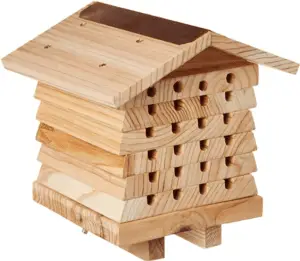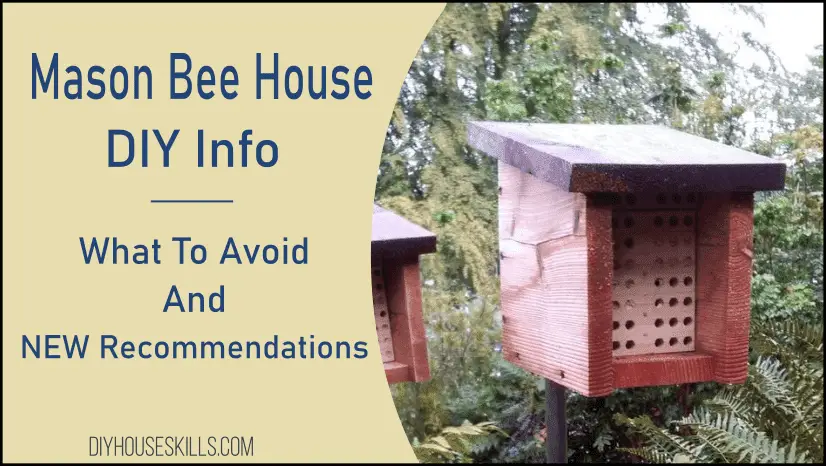Today mason bee houses have become very popular. Bees in general have been in decline which has sparked concern among many people. Building your own DIY backyard mason bee house is a project anyone can tackle with just a few materials and planning.
Start with wood blocks or paper tubes, drill some holes and mount the bee house to a sturdy structure. Read for more information on the proper way to support mason bees and what not to do so as not to harm the bees.
What Is A Mason Bee?
The name Mason bee refers to several solitary bees in the genus Osmia. The US Forest service says there are 140 species of Osmia in North America. They use mud to construct their nests or cells, hence the name ‘mason’.
They are more efficient pollinators than honeybees because they carry pollen on their bellies.
As noted above, mason bees are solitary and do not build hives or have a queen.
They are active for a relatively short time in the garden, about a month or so in the early spring.
What Is The Difference Between A Mason Bee And A Honey Bee?
- Mason bees are solitary and build nests in holes whereas honey bees build hives and live in colonies.
- A female mason bee is much more efficient at collecting pollen than a honey bee.
- Mason bees generally are reluctant to sting, and if they do their sting is fairly mild.
- Mason bees forage for food in a relatively short distance, about 300ft radius. Honey bees travel much longer distances for food foraging.
How Do You Attract And Keep Mason Bees?
Mason bees need a supply of water and mud to build their nests. Keep a source nearby for them to easily access.
In early spring, place their house or nesting tubes close to a source of food and mud. According to the honey bee conservancy: “Of the bee species native to the US, mason bees are one of the easiest to keep.”
How Do You Make A Mason Bee House?
There are several ways to construct a mason bee house.
1) The first way is to simply use a thick piece of untreated lumber, something like a block of wood. Stay away from a fresh piece of cedar. You could also use logs cut to length.
Drill holes into the block of wood at least 6 inches deep and 5/16″ in diameter. You can vary the depth of the holes but do not drill all the way through the wood.
Ensure you use a sharp drill bit and that the holes are smooth without any rough edges. Mason bees will avoid a hole that is rough as it can damage it’s wings.
Mason bees control the gender of their brood by the placement of their eggs. Eggs placed in the back of the holes will be female, while eggs placed further to the front will be male.
Add a roof or overhang that extends at least 2″ over the holes to protect them from the elements.
2) A second way to build a house is to use tubes. Either cardboard tubes or paper straws can be used. Make sure the holes are 5/16″ in diameter and at least 6 inches deep and that the back ends are blocked and not open.
These materials will need to be replaced regularly so they don’t promote disease.
These tubes should be bundled and placed in a structure with a 2″ to 3″ overhang for protection.
What Is The Best Mason Bee House?
The best mason bee house is one that will support and protect the bees. One that is cleaned after each use and free from disease and parasites.
Choosing a material such as paper tubes or straws as inserts helps promote a healthy environment because the tubes can be replaced every year.
Below is a picture of a well designed mason bee house. The wood blocks can be separated for cleaning and has a roof overhang. You can use paper inserts too in this model. The picture is an Amazon affiliate link, which I receive a commission from.
 |
| Wildlife World Bee House From Amazon.com |
What To Avoid In A Mason Bee House?
- Avoid materials that can hold moisture and rot. It is suggested that bamboo is not the best material to use. Some store bought bee houses contain cheap materials that don’t dissipate moisture and therefore promote disease and parasites.
- Avoid using one large block of wood. It is better to use several smaller blocks of untreated wood so you can rotate them out at the end of the season. That is, place a new fresh block of wood outside while the old one sits out a season.
- Avoid messing with or moving a bee house once it is mounted outside. You could dislodge or disrupt the bee activity.
- Avoid hanging or having your bee house move in the wind. It needs to be secure and stable or the bees will ignore it.
What Direction Should A Mason Bee House Face?
A mason bee house needs to face the early morning sun. Place it in the direction of the east or south east.
As to how high to mount a mason bee house, mount it to a sturdy structure about 3 to 5 feet off the ground so it does not blow or move in the wind.
When Should You Hang A Mason Bee House?
Hang or place a mason bee house in the early spring as this is when the bees are active. They will soon find the house and start to build their nests.
Can You Paint A Mason Bee House?
Yes, you can paint a bee house but allow it plenty of time for the odor to dissipate or bees will avoid it. It is preferable to leave the house unpainted and natural.
What Is The Life Cycle Of A Mason Bee?
Good question. Mason bees live for roughly a year.
Spring: Fully formed adult mason bees emerge from their cocoons. The males emerge first and then the females. This can happen over a couple of weeks. The females start foraging, during which they pollinate, and look for new nest holes. They will then lay an egg and wall it off with mud, repeating this cycle until the nest hole is filled.
Summer: The larvae hatch and feed on the previously deposited nectar until they are grown. They then form a cocoon and turn into pupa. After which they will develop into an adult.
Fall And Winter: Adult mason bees are dormant in their cocoon during the fall and winter. The cooler weather is important to the growing of the adult bee. As the temperature rises to about 50F to 55F degrees the bees will start to emerge in the spring and live for 4 to 6 weeks.
What Do You Do With A Mason Bee House In The Winter?
For safe keeping during the winter, you can remove wood with occupied holes or cells and store them in a cool, dry place. A storage shed or unheated garage or even a covered patio. The point is to protect it from predators such as birds but also allow it to be in the cooler temperatures.
When Should I Clean My Mason Bee House?
Start by choosing material that can dry and not hold water, which promotes disease and parasites.
In the spring, once the adult mason bees have left the house but before they start to re-populate it, clean and sanitize the holes of the house with a 50% bleach/water solution or replace the paper straws. You can tell when they have left by exit holes made in the dried mud.
What Do You Do With Mason Bee Cocoons?
In early spring, you can remove the cocoon filled tubes from the house, or the whole block of wood, and place them in in a cardboard box with small hole in it. Place the cardboard box outside in a dry location that gets morning sun so the adult bees can exit when they are ready.
Important Tips
House Materials: Use wood blocks or paper tubes, paper straws.
Pollen: Mason bees need a food source close by. They travel no more than about a 300 feet radius. Ensure pollen is close by.
Mud: Mason bees need water and mud to build their nests. Make sure both are available.
Location: Place house 3 to 5 feet off the ground, attach to a sturdy structure and face east to southeast.
Conclusion
Keeping mason bees in your backyard is both enjoyable and easy to do. It is beneficial to the environment as more bees mean more pollination of plants. Building your own mason bee house is a DIY project anyone can do with just a little time and materials. Check out: The Million Pollinator Garden Challenge (MPGC), it is “a nationwide call to action to preserve and create gardens and landscapes that help revive the health of bees, butterflies, birds, bats and other pollinators across America.” With some knowledge about materials, placement and care, you can get started building your own mason bee house.

